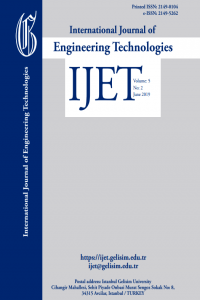Analysis of a Soft Switching High Voltage Gain DC/DC Boost Converter for PV Systems
DC/DC converter, high voltage gain, coupling inductor, voltage quadrupler, ZCS ZVS, PV system,
___
- J. M. Guerrero, F. Blaabjerg, T. Zhelev, K. Hemmes, E. Monmasson, S. Jemei, M. P. Comech, R. Granadino, J. I. Frau, “Distributed generation: toward a new energy paradigm”, IEEE Industrial Electronics Magazine, vol. 4, no. 1, pp. 52-64, March 2010.
- S. Hema, A. Arulmathy, V. Saranya and S. Yugapriya, “High voltage gain soft switching converter for solar energy AC and DC applications”, International Conference on Power and Embedded Drive Control (ICPEDC), Chennai, 2017, pp. 326-332.
- E. Mamarelis, G. Petrone and G. Spagnuolo, “Design of a sliding-mode-controlled SEPIC for PV MPPT applications”, IEEE Transactions on Industrial Electronics, vol. 61, no. 7, pp. 3387-3398, July 2014.
- C. W. Tan, T. C. Green and C. A. Hernandez-Aramburo, “Analysis of perturb and observe maximum power point tracking algorithm for photovoltaic applications”, IEEE 2nd International Power and Energy Conference, Johor Bahru, 2008, pp. 237-242.
- F. Boico and B. Lehman, “Study of different implementation approaches for a maximum power point tracker”, IEEE Workshops on Computers in Power Electronics, Troy, NY, 2006, pp. 15-21.
- B. Liu, S. Duan, F. Liu and P. Xu, “Analysis and improvement of maximum power point tracking algorithm based on incremental conductance method for photovoltaic array”, 7th International Conference on Power Electronics and Drive Systems, Bangkok, 2007, pp. 637-641.
- D. Sera, L. Mathe, T. Kerekes, S. V. Spataru and R. Teodorescu, “On the perturb-and-observe and incremental conductance MPPT methods for PV systems”, IEEE Journal of Photovoltaics, vol. 3, no. 3, pp. 1070-1078, July 2013.
- M. Das and V. Agarwal, “A novel, high efficiency, high gain, front end DC-DC converter for low input voltage solar photovoltaic applications”, IECON 2012 - 38th Annual Conference on IEEE Industrial Electronics Society, Montreal, QC, 2012, pp. 5744-5749.
- S. Sathyan, H. M. Suryawanshi, M. S. Ballal and A. B. Shitole, “Soft-switching DC–DC Converter for distributed energy sources with high step-up voltage capability”, IEEE Transactions on Industrial Electronics, vol. 62, no. 11, pp. 7039-7050, Nov. 2015.
- S. Sathyan, H. M. Suryawanshi, A. B. Shitole and G. G. Talapur, “Soft switched high voltage gain boost integrated flyback converter”, IEEE International Conference on Power Electronics, Drives and Energy Systems (PEDES), Trivandrum, 2016, pp. 1-6.
- S. Sathyan, H. M. Suryawanshi, B. Singh, C. Chakraborty, V. Verma and M. S. Ballal, “ZVS–ZCS high voltage gain integrated boost converter for DC microgrid”, IEEE Transactions on Industrial Electronics, vol. 63, no. 11, pp. 6898-6908, Nov. 2016.
- ISSN: 2149-0104
- Başlangıç: 2015
- Yayıncı: İstanbul Gelişim Üniversitesi
Roland Uhunmwangho, Berebon Victor Leesi, Ameze Big-Alabo
Akın ARAS, Murat AYAZ, Engin ÖZDEMİR, Nurettin ABUT
Erdener ÖZÇETİN, Gürkan ÖZTÜRK
Yalcin İSAYEV, Mustafa Emre AYDEMİR, Ahed İSAYEV, L.h. MAMMADOVA
Hüseyin Sağlık, Bilge Doran, Can Balkaya
